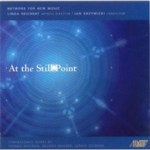This enterprising collection of contemporary chamber music features two very fine pieces, and one about which I haven’t made up my mind. Thomas Whitman’s Piano Quartet is a very finely crafted, appealing work with more than enough engaging melodic ideas to sustain the listener’s interest and justify the composer’s choice of medium. It has three movements and employs cyclical form, but at the same time it manages to absorb its traditional elements into an obviously contemporary idiom. Melinda Wagner’s Romanz with Faux Variations is a single-movement piano trio in several loosely connected episodes. The cute title basically says it all: the episodes aren’t really variations in the strict sense, but it all hangs together and features some very exciting ensemble writing in the process.
Gerald Levinson’s At the Still Point of the Turning World, There the Dance Is makes one critical mistake: its title promises more than the music can possibly deliver. This is one of those frequently-encountered modern pieces for a typically eclectic mixture of strings, winds, keyboards, and percussion–instruments that have little or no reason to be together at all other than the fact that they happen to be in the same place at the same time. Levinson packs the work with all kinds of ideas that he claims are related to one another, and maybe they are, but despite a number of tantalizing moments, the piece never quite gels (at least for me; you may hear it differently). That said, the performances by the Network for New Music are totally dedicated, polished, and very well recorded. Most contemporary music collections contain an assortment of hits and misses, and that’s the nature of this particular beast, although the rewards here certainly predominate.
































